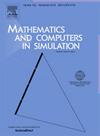非线性速度耦合cucker - small系统的模式形成
IF 4.4
2区 数学
Q1 COMPUTER SCIENCE, INTERDISCIPLINARY APPLICATIONS
引用次数: 0
摘要
本文提出了一种具有非线性速度耦合和目标驱动力的新型cucker - small系统。首先,通过对初始状态施加假设,使系统能够实现群集行为。其次,应用三角不等式推导了不同速度耦合度下的避碰结果。第三,通过运用barbarlat引理,所有agent最终在目标驱动力下达到规定的线状队形。特别是对于1/2<;α<;1和1<;β<3/2,无需符号函数即可成功实现有限时间和固定时间的线形形成,并获得了沉降时间的上界。最后,通过数值模拟验证了理论分析的结果,并利用最小二乘法导出了最终地层的轨迹方程。本文章由计算机程序翻译,如有差异,请以英文原文为准。
Pattern formation of Cucker–Smale system with nonlinear velocity couplings
In this paper, we propose a novel Cucker–Smale system with nonlinear velocity couplings and a targeted driving force. Firstly, by imposing assumptions on the initial state, the system can achieve flocking behavior. Secondly, the collision avoidance results under various velocity coupling degrees are deduced by applying the triangle inequality. Thirdly, by applying the Barblat’s lemma, all agents eventually reach the prescribed line-shaped formation with a targeted driving force. In particular, for and , the finite-time and fixed-time line-shaped formation can be successfully achieved without the symbolic function, and an upper bound on the settling time is obtained. Finally, the results of the theoretical analysis are verified by numerical simulations, and the final formation’s trajectory equation is derived by using the least squares method.
求助全文
通过发布文献求助,成功后即可免费获取论文全文。
去求助
来源期刊

Mathematics and Computers in Simulation
数学-计算机:跨学科应用
CiteScore
8.90
自引率
4.30%
发文量
335
审稿时长
54 days
期刊介绍:
The aim of the journal is to provide an international forum for the dissemination of up-to-date information in the fields of the mathematics and computers, in particular (but not exclusively) as they apply to the dynamics of systems, their simulation and scientific computation in general. Published material ranges from short, concise research papers to more general tutorial articles.
Mathematics and Computers in Simulation, published monthly, is the official organ of IMACS, the International Association for Mathematics and Computers in Simulation (Formerly AICA). This Association, founded in 1955 and legally incorporated in 1956 is a member of FIACC (the Five International Associations Coordinating Committee), together with IFIP, IFAV, IFORS and IMEKO.
Topics covered by the journal include mathematical tools in:
•The foundations of systems modelling
•Numerical analysis and the development of algorithms for simulation
They also include considerations about computer hardware for simulation and about special software and compilers.
The journal also publishes articles concerned with specific applications of modelling and simulation in science and engineering, with relevant applied mathematics, the general philosophy of systems simulation, and their impact on disciplinary and interdisciplinary research.
The journal includes a Book Review section -- and a "News on IMACS" section that contains a Calendar of future Conferences/Events and other information about the Association.
 求助内容:
求助内容: 应助结果提醒方式:
应助结果提醒方式:


